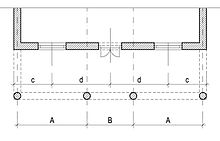Axial dimension
The axis dimension is a term from architecture and construction .
It denotes the distance between two characteristic lines, center lines or lines of symmetry on building sections or components (e.g. on beams , columns and the like) or the distance between two openings, measured from their center.
In historical buildings, the axial dimension was mainly important for aesthetic reasons (symmetry of facades , equal distances, proportion to one another, etc.). In modern buildings, especially office buildings, hotels or farm buildings such as halls, the same center distances (axis dimensions) are important for economical, cost-effective construction, especially in precast construction . The axis dimension is important when planning and manufacturing using CNC-controlled machines.
A distinction is made between:
- Axial dimension
- Waistband
- clear width
literature
- Hansjörg Frey (Red.): Structural engineering: Technical drawing. 6th edition, Europa-Lehrmittel, Haan-Gruiten 2010, ISBN 978-3-8085-4146-3
Web links
- Example on www.massivbau.de
- Axial dimensions in office buildings at www.vbg.de
